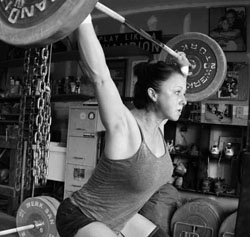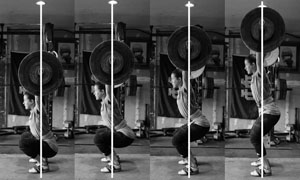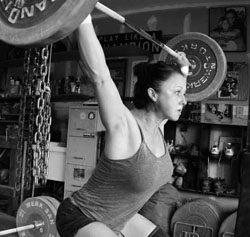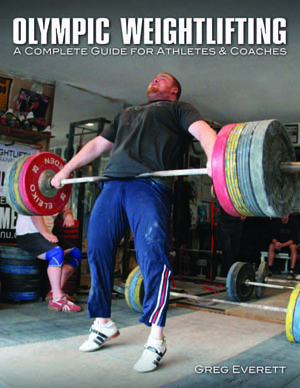The Snatch Overhead Position

The overhead position of the arms and bar in the snatch, as it will be in the jerk, is critical for successful lifting. In preparation for receiving and supporting heavy loads, we need to establish extremely strong and structurally sound positioning.
With a snatch-width hand placement and no hook grip, the athlete will place the PVC bar across the shoulders behind the neck as he or she would for a back squat and press it straight overhead without altering the position of the torso. This will place the torso at a slight forward incline, and the bar directly over the rearward base of the neck. The bar must also be centered directly over the lifter’s base—a vertical line drawn to the floor from the center of the bar’s diameter should pass through the foot just in front of the heel. Despite any changes of surrounding body positions during the overhead squat or snatch recovery, this spatial relationship of the bar to the feet must remain essentially the same. That is, even when the torso inclines forward to the greatest degree during the squat movement, the bar will remain above the center of base through the slight shifting of the arm position relative to the torso. Failure to maintain this position within a tight tolerance will result in the inability to support the load.
The arms in the overhead position are acting essentially as support columns. As such, their rigidity is imperative. A fully extended elbow will create a remarkably solid structure able to withstand extremely great compressive forces. Attempting to support a similarly heavy load with even slightly flexed elbows will provide markedly more difficult and, with the exception of pre-approved medical conditions preventing full elbow extension, any elbow flexion during the receipt and support of the snatch will prevent the lift from passing in competition, a rule that should be observed equally in training for the sake of maintaining consistent standards and accurate measurement of progress.

In this position, the elbows should be pointed downward and back. This position will provide the greatest structural stability for two basic reasons. First, this elbow orientation encourages correct positioning of the shoulder blades; second, if the elbows are oriented directly downward, the force of the weight must be resisted almost entirely by muscle strength—with the elbows turned back partly, the rigid structure of the skeleton can assist in supporting the load.
Elbow orientation can be manipulated, and often will be naturally without consideration, during the recovery of a lift to save a barbell that has failed to come to rest precisely in the desired position. This manipulation will be minor and affect only minor change—it will not overcome the imbalance of a significantly misplaced barbell. Turning the elbows back more will help pull the bar backward, while rotating them down more will help pull the bar forward.
Shoulder position with the bar overhead has a dramatic effect on both the success and safety of the lift. We want to create a solid base of support for the arms that will both allow the proper balance of the bar over the feet, connect as tightly as possible the bar to the body, and stabilize the shoulders against unwanted movement. This is best achieved by powerful retraction and elevation of the scapulae—pulling the shoulders blades back together and up—anchoring the arms securely to the body and preventing potentially injurious shifts in shoulder position. This position is extremely active and a reduction in the effort to maintain it will result in unnecessary struggle to recover from the snatch or a failure to recover at all, as well as allow greater opportunity for injury.

In order to achieve this position of the scapulae and maintain the bar positioning over the feet, the head must be pushed forward through the arms and the torso inclined forward slightly. Attempts to maintain a completely vertical torso and head will prevent the scapulae from being able to reach proper retraction due to the demands of bar positioning over the feet. Generally athletes will be more successful achieving this position by first retracting and then elevating the scapulae instead of in the other order or simultaneously. The correct shoulder and elbow position can generally be best achieved by the athlete attempting to push the barbell up and turn the palms to the sides.
The overhead position of the bar will usually be thought of as the end of a rotation of the arms into place as appears to occur in the snatch. In reality, the final phase of the third pull is actually a push under the bar. This being the case, the idea of rotation will work satisfactorily with light weights and lifters for whom this position is at the margin of shoulder flexibility, but with heavier loads and for those more flexible, it will encourage over-rotation and placement of the bar behind the base of support, as well as reduce the speed of the final stage of the pull under the bar. This being the case, it will be better from the earliest stages of learning to encourage considering the position as one of pushing the bar straight up instead of rotating it back. An active drive up on the bar immediately following the turnover will be imperative during the receipt of a snatch to prevent structural collapse
.
There are some advocates of “packing” the shoulder in overhead movements; that is, pulling the shoulder down as tightly to the body as possible in order to maximize shoulder stability and safety. While well-intentioned, this recommendation is a product of a basic misunderstanding of shoulder anatomy.
There are a few things to consider. First, the glenoid is part of the scapula—so the glenohumeral joint goes wherever the scapula goes unless the shoulder is dislocated. The idea that elevating the shoulders is somehow pulling the head of the humerus out of the “socket” doesn’t make sense for that reason, and further, because the elevation occurs from the traps’ action on the scapula, not the humerus, elevating the scapula pulls the glenoid up into the humerus while shoulder flexion pulls the humerus down into the scapula; if anything, this creates a tighter joint than packing.
Second, the most vulnerable part of the shoulder joint is the inferior aspect. If we elevate the structure with the traps, we then have a way to absorb downward ballistic forces through slight elongation of the traps instead of having the head of the humerus slammed directly down against the very small, weak structures that hold it into the joint at the bottom.
Third, elevation brings the clavicles up, which opens up the acromioclavicular joint and allows the humerus more space to travel. With most athletes, this can be demonstrated very clearly by having them with a straight elbow try to place their arm perfectly vertical with the torso perfectly vertical, and either elevate or relax the scapula. Invariably, when relaxed, the humerus is pushed out a slight angle, and this is accompanied by a pinching sensation.

With a snatch-width hand placement and no hook grip, the athlete will place the PVC bar across the shoulders behind the neck as he or she would for a back squat and press it straight overhead without altering the position of the torso. This will place the torso at a slight forward incline, and the bar directly over the rearward base of the neck. The bar must also be centered directly over the lifter’s base—a vertical line drawn to the floor from the center of the bar’s diameter should pass through the foot just in front of the heel. Despite any changes of surrounding body positions during the overhead squat or snatch recovery, this spatial relationship of the bar to the feet must remain essentially the same. That is, even when the torso inclines forward to the greatest degree during the squat movement, the bar will remain above the center of base through the slight shifting of the arm position relative to the torso. Failure to maintain this position within a tight tolerance will result in the inability to support the load.
The arms in the overhead position are acting essentially as support columns. As such, their rigidity is imperative. A fully extended elbow will create a remarkably solid structure able to withstand extremely great compressive forces. Attempting to support a similarly heavy load with even slightly flexed elbows will provide markedly more difficult and, with the exception of pre-approved medical conditions preventing full elbow extension, any elbow flexion during the receipt and support of the snatch will prevent the lift from passing in competition, a rule that should be observed equally in training for the sake of maintaining consistent standards and accurate measurement of progress.

In this position, the elbows should be pointed downward and back. This position will provide the greatest structural stability for two basic reasons. First, this elbow orientation encourages correct positioning of the shoulder blades; second, if the elbows are oriented directly downward, the force of the weight must be resisted almost entirely by muscle strength—with the elbows turned back partly, the rigid structure of the skeleton can assist in supporting the load.
Elbow orientation can be manipulated, and often will be naturally without consideration, during the recovery of a lift to save a barbell that has failed to come to rest precisely in the desired position. This manipulation will be minor and affect only minor change—it will not overcome the imbalance of a significantly misplaced barbell. Turning the elbows back more will help pull the bar backward, while rotating them down more will help pull the bar forward.
Shoulder position with the bar overhead has a dramatic effect on both the success and safety of the lift. We want to create a solid base of support for the arms that will both allow the proper balance of the bar over the feet, connect as tightly as possible the bar to the body, and stabilize the shoulders against unwanted movement. This is best achieved by powerful retraction and elevation of the scapulae—pulling the shoulders blades back together and up—anchoring the arms securely to the body and preventing potentially injurious shifts in shoulder position. This position is extremely active and a reduction in the effort to maintain it will result in unnecessary struggle to recover from the snatch or a failure to recover at all, as well as allow greater opportunity for injury.

In order to achieve this position of the scapulae and maintain the bar positioning over the feet, the head must be pushed forward through the arms and the torso inclined forward slightly. Attempts to maintain a completely vertical torso and head will prevent the scapulae from being able to reach proper retraction due to the demands of bar positioning over the feet. Generally athletes will be more successful achieving this position by first retracting and then elevating the scapulae instead of in the other order or simultaneously. The correct shoulder and elbow position can generally be best achieved by the athlete attempting to push the barbell up and turn the palms to the sides.
The overhead position of the bar will usually be thought of as the end of a rotation of the arms into place as appears to occur in the snatch. In reality, the final phase of the third pull is actually a push under the bar. This being the case, the idea of rotation will work satisfactorily with light weights and lifters for whom this position is at the margin of shoulder flexibility, but with heavier loads and for those more flexible, it will encourage over-rotation and placement of the bar behind the base of support, as well as reduce the speed of the final stage of the pull under the bar. This being the case, it will be better from the earliest stages of learning to encourage considering the position as one of pushing the bar straight up instead of rotating it back. An active drive up on the bar immediately following the turnover will be imperative during the receipt of a snatch to prevent structural collapse
.
There are some advocates of “packing” the shoulder in overhead movements; that is, pulling the shoulder down as tightly to the body as possible in order to maximize shoulder stability and safety. While well-intentioned, this recommendation is a product of a basic misunderstanding of shoulder anatomy.
There are a few things to consider. First, the glenoid is part of the scapula—so the glenohumeral joint goes wherever the scapula goes unless the shoulder is dislocated. The idea that elevating the shoulders is somehow pulling the head of the humerus out of the “socket” doesn’t make sense for that reason, and further, because the elevation occurs from the traps’ action on the scapula, not the humerus, elevating the scapula pulls the glenoid up into the humerus while shoulder flexion pulls the humerus down into the scapula; if anything, this creates a tighter joint than packing.
Second, the most vulnerable part of the shoulder joint is the inferior aspect. If we elevate the structure with the traps, we then have a way to absorb downward ballistic forces through slight elongation of the traps instead of having the head of the humerus slammed directly down against the very small, weak structures that hold it into the joint at the bottom.
Third, elevation brings the clavicles up, which opens up the acromioclavicular joint and allows the humerus more space to travel. With most athletes, this can be demonstrated very clearly by having them with a straight elbow try to place their arm perfectly vertical with the torso perfectly vertical, and either elevate or relax the scapula. Invariably, when relaxed, the humerus is pushed out a slight angle, and this is accompanied by a pinching sensation.

| Greg Everett is the owner of Catalyst Athletics, publisher of The Performance Menu Journal and author of Olympic Weightlifting: A Complete Guide for Athletes & Coaches, Olympic Weightlifting for Sports, and The Portable Greg Everett, and is the writer, director, producer, editor, etc of the independent documentary American Weightlifting. Follow him on Facebook here. |
Search Articles
Article Categories
Sort by Author
Sort by Issue & Date
Article Categories
Sort by Author
Sort by Issue & Date

